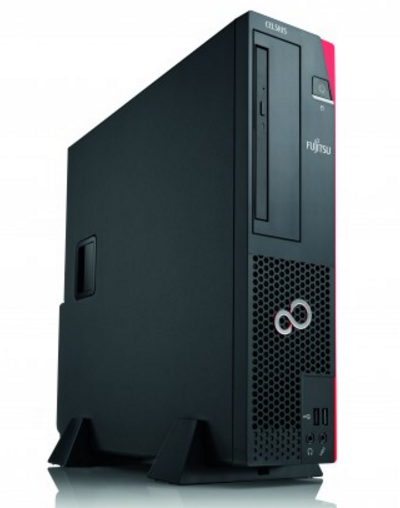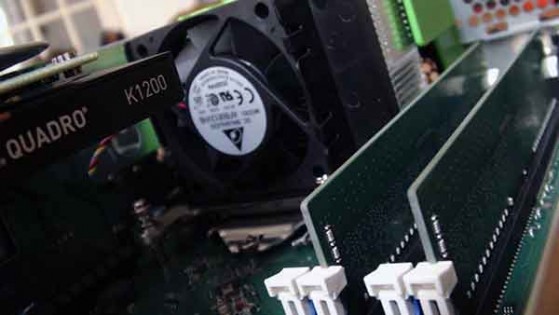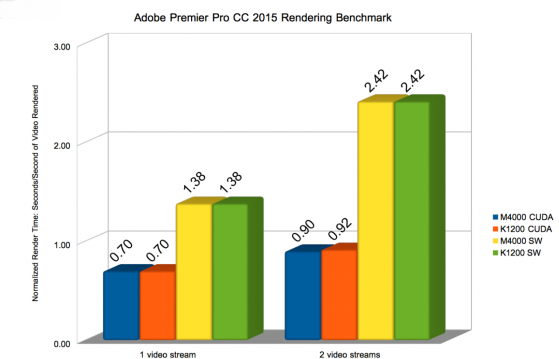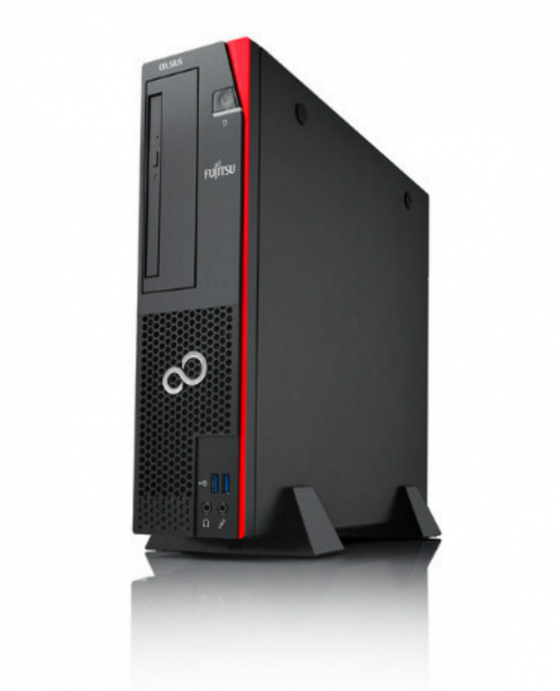Full-size graphics and storage in a tiny box.
By Tom Lansford
The amount of performance that can be packed into a 10-liter small form-factor workstation just jumped – a lot.
Fujitsu has been designing and manufacturing professional workstations in Germany for 25 years. They just released the company’s first small form-factor workstation. This 10 liter form-factor is typically reserved for the entry-level workstation segment. By combining the latest workstation platform with a unique design that packs full-height graphics into a tiny system, the result is anything but entry-level performance The Fujitsu team in Augsburg performed similar magic with its new Celsius W550 mini-tower workstation. The mini-tower model can deliver high-performance 3D graphics, 64 GB of main-memory, and a whopping 27 TB of mass storage in an entry-level workstation.

Possibly the most powerful SFF workstation on the market
Looking at the small form-factor, Celsius J550, the well-balanced system can deliver the following configuration:
- Nvidia Quadro K2200 with 4GB of GDDR5 memory
- 64GB of 2133 MHz memory
- A 3.7GHz Intel Xeon E3-1280 v5 (up to 4GHz)
- 14.5TB of mass storage
You would need to be an extremely high-end user to consider that configuration “entry-level.”
While the Quadro K2200 is the fastest GPU available in the Celsius J550, our system was equipped with a very capable Quadro K1200, 16GB of memory and a fast 512GB SSD drive. Both systems were tested on the Fujitsu P27T-7 UHD display with a 3840 x 2160 resolution. The Quadro K1200 supports 4K resolutions, and we appreciate the board’s design with 4 Mini DisplayPort outputs and the ability to drive four 4K monitors simultaneously. The Quadro K1200 is based on Nvidia’s efficient Maxwell GPU architecture, has 4GB of memory, and delivers excellent 3D performance in a small package.
When it comes to multiple display configurations, the new 550 series of workstations can be equipped with Nvidia NVS 510 and NVS 315. These are specialized workstation graphics cards targeting 2D multi-monitor applications and with these GPUs, it is possible to connect 8 displays to a single workstation.

The Intel Skylake Xeon E3-1275 v5 CPU delivers around 20% faster performance than the previous generation. And the new platform supports 64GB of main memory – twice the previous generation. Combined with Nvidia’s Quadro performance, this one-two punch delivers much of the extraordinary performance found in the Celsius J550.
The system ships with 64-bit Windows 7 pre-installed as well as the installation DVDs for Windows 10. We installed Windows 10 and checked the performance and applications. Everything worked and performed as expected.
Fujitsu’s unique design allows a full-height GPU in the system by plugging the graphics card into a riser-board which positions the graphics card parallel to the motherboard. This design allows the small form-factor Celsius J550 to use larger, more powerful graphics than other small form-factor workstations.
Fujitsu took advantage of this design to build in special options. Many workstation customers use these products in specialized industrial environments which require the ability to use legacy PCI boards. Fujitsu provides a special-order model of the J550 with a riser-board containing a PCI slot next to the graphics card in the PCI Express slot.
Celsius W550 mini-tower
The Celsius W550 is the mini-tower version of this platform. It supports the new Skylake CPUs and 64GB of memory. Our test unit had the 3.6 GHz Intel Xeon E3-1275 v5 CPU and a 500W power supply. The Quadro M4000 draws 120W which requires connecting an additional 6-pin connector from the power supply to the back of the board. The additional power allows you to enjoy the 3D and GPU-computing performance of a GPU with 1664 CUDA cores, 192 GB/S memory bandwidth to 8GB of GDDR5 memory, and four DisplayPort outputs. On the top of the Quadro M4000 are 3 specialized connectors for 3D stereo, display synchronization of multiple monitors, and Nvidia’s multiple graphics card acceleration technology, SLI. That level of performance and the extra features are condensed into a full-height, single-slot GPU solution The Celsius W550 has nearly double storage capacity of its smaller brother. The W550 can be configured with more than 27TB of storage. The combination of a faster CPU, more main memory, high-end 3D graphics, and massive storage capacity redefines the meaning of entry-level workstations.
Fujitsu created an option for a three-year minimum lifecycle on the Celsius W550. We have not seen this offer of guaranteed availability of a workstation for a minimum of 36 months from any other workstation provider.
Our test results are below. The Quadro M4000 performance driven by a 3.6 GHz CPU makes this workstation stand out as a 3D performer for high-end interactive 3D modeling & visualization applications. This level of performance delivers the most powerful “entry-level” workstation we have seen to date. The Quadro M4000 performance compares favorably against the Quadro K5200 which we tested at the beginning of the year.
The right display system
Given the 4 times 4K monitor support on the Quadro K1200 and the Quadro M4000, it makes sense to test these workstations on a high-resolution display. Both workstations were tested on Fujitsu’s 4K-resolution monitor, the P27T-7 UHD model. The image quality is solid, and the screen real estate ample The monitor provides inputs for the Quadro’s DisplayPort & Mini DisplayPort as well as for HDMI. It functions in either landscape or in portrait mode. The menu controls are clearly visible, right in the front, and easy to set up. Its display uses in-plane switching (IPS) with LED backlighting. IPS provides a display with a wide viewing angle and high contrast. The P27T-7 UHD adds a picture in picture feature that can display images from a second input source and it also supports HDMI with MHL input for connecting tablets and smartphones.
The Made in Germany Advantage
These two workstations share several benefits and no small part of that comes from their German origins. Perhaps being nestled in the land of Audi, BMW, and Daimler Benz has given the Augsburg team a penchant for design, quality, and reliability. Whatever the reason, two points stand out:
- Attention has been paid to ergonomics. Both systems are exceptionally quiet while in operation. The Celsius W550 runs at a very quiet 18 dB(A) level of noise emission.
- Both systems benefit from extensive testing and quality assurance with certifications from the developers of professional applications (ISV certifications).
Interactive 3D Performance
SPECviewperf 12 is developed by the industry group SPEC to measure the performance of a graphics workstation. Below are the results for the Celsius J550 & Celsius W550. Both systems have a 3.6GHz Intel Xeon E3-1275 v5. Therefore the comparison shows the performance difference between an Nvidia Quadro K1200 and an Nvidia Quadro M4000.
SPECviewperf 12:
| Viewset | CELSIUS J550
Quadro K1200 |
CELSIUS W550
Quadro M4000 |
| catia-04 | 31.19 | 85.02 |
| creo-01 | 29.66 | 72.44 |
| energy-01 | 2.3 | 5.74 |
| maya-04 | 27.8 | 69.97 |
| medical-01 | 10 | 25.25 |
| showcase-01 | 16.73 | 42.96 |
| snx-02 | 25.39 | 75.5 |
| sw-03 | 61.79 | 111.26 |
The above table shows you can expect roughly two to three times faster raw-graphics performance from the Quadro M4000. The 3D performance of the Quadro K1200 is already quite good for interactive CAD and 3D modeling. Consider that the Quadro K1200 also supports 4K resolutions and can drive four 4K displays from a single board. Therefore, a Quadro M4000 with much higher performance, additional connectors for 3D stereo, display synchronization, and SLI, and double the graphics memory, targets more complex projects and very demanding 3D applications. The Quadro M4000 makes it possible for the Celsius W550 to have graphics performance which matches the Quadro K5200, a 2-slot graphics solution drawing 150W power.
Looking at CPU and GPU workloads
Next we loaded and tested high-end video-editing and special effects software from Adobe, Premier Pro CC 2015 and After Effects CC 2015.
Adobe Premier Pro uses their Mercury Playback Engine (MPE) to render video files. This engine can render using only the CPU or it can render using the GPU + CPU. The MPE is used to render final video output and it is also used to render video during the editing session. This means that our test results do not only apply to the final rendered video, but they also describe the performance of your workstation throughout the project.
To investigate how the system performs under a range of conditions. We set up our test video file with different tests. All video segments are HD and all video segments use color correction effects. The benchmark here renders one single video stream with effects and then renders 2 concurrent video streams with effects. Any number of scenarios support testing multiple video stream conditions: titling, overlaying effects, merging multiple cameras, and inserting secondary images are a few examples.
Working in real time
The results make it clear – if you are not using a Quadro in Premiere Pro, then you are not working in real time. Whether one or two simultaneous video streams, MPE using CUDA renders a second of video in under one second. In contrast, MPE using CPU-rendering always renders slower than real time and it renders 2 to 2 ½ times slower than when using the Quadro GPU. This slows down your editing work and more than doubles final rendering times.

Adobe After Effects (AE) is used to create, modify, and render special effects. It places extremely high demands on your workstation, and does not, for all practical purposes, leverage the power of the GPU. Under these conditions, we verified multiple configurations. With the systems using the same model of CPU and having similar storage and memory configurations, there was no difference between the two workstations. A final issue with benchmark testing After Effects comes from AE rendering time fluctuations. It is possible to render exactly the same sequence repeatedly and have render times differ by more than 20%. Below you see four rendering times and the average. We rendered a sequence from the CADplace logo video introduction.
| After Effects CC 2015 Render Test | Results in seconds:number of seconds to render one second of video | ||||
| Test 1 | Test 2 | Test 3 | Test 4 | AVERAGE | |
| Intel Xeon E3-1275 v5 @ 3.6Ghz | 113.33 | 100.00 | 123.00 | 123.33 | 114.92 |
The conclusion from AE testing is simple. You need the maximum computing power for After Effects. Where Premiere Pro can be rendered in real time using a Quadro, After Effects takes 100 seconds or longer in order to render a second of video in our tests. As for which Quadro is the right choice for video-editing with Premiere Pro and After Effects, the Quadro K1200 delivers the same benefits as the Quadro M4000, so if you don’t use high-end 3D companion applications in your video workflow, then chose the Quadro K1200.
What do we think?
These new workstations share a powerful new platform. New graphics architectures, new levels of system memory, denser and faster storage technologies, and faster processing power converge in this new workstation generation and create a leap in performance for these workstations. Additionally, the Fujitsu design team in Germany created quiet, ergonomic designs with extra features for customers.
The new Nvidia Quadro GPUs drive ultra-high-definition resolution displays, and these GPUs can drive four of them simultaneously. Combined with new Intel Xeon CPUs, 64 GB of memory, and huge storage capacities, the Celsius J550 AND W550 performed well beyond our expectations. This performance head-room can be an important benefit to customers and it redefines the meaning of an “entry-level” workstation.
Tom Lansford is a marketing consultant who has been working in the professional workstation, graphics, and engineering software markets for more than 25 years.






